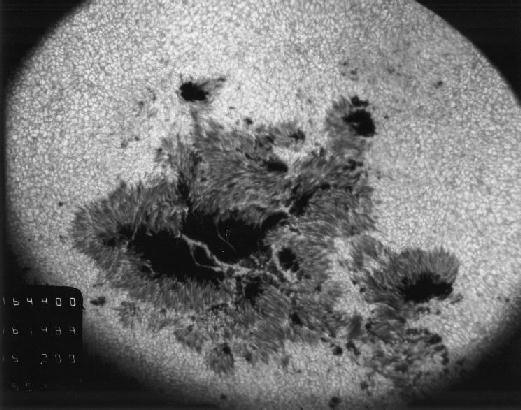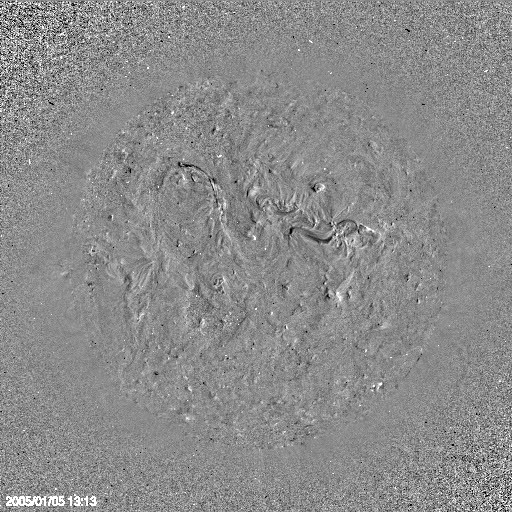Sunquakes, Solar Flares,
Solar Prominence, Flare Activity, Solar Eruptions
& Tsunamis
Sunquakes and solar flare activity are two
of the great remaining mysteries of the sun. This
"Granddaddy"
solar flare prominence was recorded in 1945 and remains the largest recorded
flare on video record. Sometimes a sunquake results in the solar flare,
but a sunquake is not necessarily the only thing that can trigger a solar
flare.
The continuous erosion from the electrical arcing at the surface of the sun occasionally
weakens the surface along large fault lines resulting in sunquakes. These fault lines
eventually rupture and generate solar flare activity, releasing huge amounts of heat and energy from the hot, dense
magma-like layers below the surface of the sun. This can often set off spectacular
solar flares. The hot magma rushing in to fill in the crack along the surface, heats up the plasma of the photosphere
and the plasma rises. The superheated plasma column flows upwards until it reaches the thinner
layer of the chromosphere, where gravity quickly takes over.
As this heated plasma column rises and finally reaches the chromosphere, it first
pushes through the neon layer of the
penumbral filaments
at the very top of the photosphere revealing the dark surface of the sun below
and a clear silicon layer between the neon layer and the surface.
In this close-up of a sunspot, we can actually see through this hole in the
penumbral filaments to the surface below and see the jagged-edged cracks in the
surface that caused these unusual patterns in the missing penumbral filaments.
It is actually only the upper layer of the photosphere, the thin neon layer of the
penumbral filaments,
that release "light" in the optical wavelengths our eyes can see. When the
silicon layer below is layer is heated up by electrical activity or surface
eruptions, the silicon plasma pushes through the neon layer of the penumbral
filaments. Without the structures of the penumbral filaments to ionize the
neon, visible light is
no longer produced in that region of the photosphere where the photosphere has
pushed through the neon, and to our eyes, a hole
forms in the photosphere. The photosphere is
still there, but not the neon light emitting layer of the
penumbral filaments.
They have been temporarily pushed aside by the rising column from within lower
layers of the photosphere. Once things cool off on the surface
below, and the silicon plasma column stops rising, the neon layer rushes in the
close the hole.
In the top photo of this page, surface cracks below are clearly visible in the
center of the sunspot, or the hole produced by the missing (neon) penumbral
filaments. Whatever light is coming up from us in the center of the hole
cannot be coming from the missing penumbral filament layer of the photosphere
itself. It must come from BELOW the filament layer. If you notice on
the right side of the hole, you can see there is actually a jagged "V" shaped crack
in the surface below. The heat from the magma of the sun in those cracks
passed into the plasma of the photosphere, which rose to the surface of the
photosphere, and dissolved pushed into the penumbral filament layer in a V like configuration. The
shape of the cracks at the surface determined the filament patterns we
see in the photosphere.
The neon layer that composes the penumbral filaments is the
layer our eyes can see. This layer has another VERY important function,
specially to COOL the lower layers. Neon is used as a cryogenic
refrigerant because of its incredible "cooling" abilities. This layer not
only makes it possible to see during the day, it also keeps the surface cool to
allow for the formation of a metallic surface the sits beneath this layer.
As you look at the following
video (voice by William Shatner), notice during the flare segment that "cracks" form on
the surface. These cracks fill up with hot magma from underneath the
surface. The magma below rises to fill the crack and for a while
this magma glows brightly. Eventually these cracks start to solidify and
become dark, just as we would expect magma to cool. The SERTS
program also records the presence of sulfur during "active phases", making it
likely that volcanic activity is inolved.
SOHO witnessed something quite remarkable on January 5th 2005
and a second time, just 10 days later on
January 15th 2005. On those
days, SOHO captured video of two truly MASSIVE sunquakes along a common fault
line that spanned
about half of the visible surface of the sun. These ruptures clearly
demonstrate that the sun's surface is composed of various "tectonic plates" that
can and do rupture much as they do here on earth. The ruptures even
progress along fault lines, just as they do here on earth.
I boxed the affected area in pink in the upper photograph and I've drawn (rather
crudely) a series of blue lines slightly below the fault line that ultimately
ruptures. You'll note that the rupture progresses along the fault line
from right to left throughout the day. The following photographs show the progression of the sunquake
on January 5th,
as the fault line continues to break from right to left. Notice the
sharply delineated fault line in the top photograph running from top to bottom
along the left side of the pink box. Such lines are unusual on a day by
day basis, but such surface cracks do occur and rupture regularly. As
you'll see, when they rupture they release massive amounts of energy and trigger
huge solar eruptions.
The second photo shows the first large break of the tectonic plate as the rupture begins along
the right side of the sun. The black dot in the upper right corner
represents the furthest point of the fault. That same dot is clearly
visible in the upper photograph directly above the blue line. As you'll
see in the following shots, the
break in the surface follows the contour of the surface that ultimately becomes
more clearly visible as the break continues and culminates in a massive rupture
that occurs at 15:24.
While the photos themselves demonstrate what's going on, the actual raw video is
much more dynamic and reveals much more than a few photos. You can
download these 10+ Megabyte files by clicking on the links provided, or you can
download these videos yourself at SOHO's website. I have not tampered with
or
altered any materials I've posted here, except for the colored lines I added to
the first photograph in to illustrate the fault line. All the other photos
are directly taken from the actual SOHO video as snapshots from Apple's Quicktime video player. All of the DIT videos are available at directly
from SOHO's website.
I have simply provided them here for your convenience.
| 
